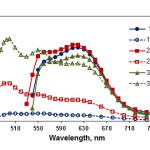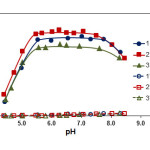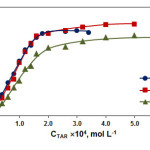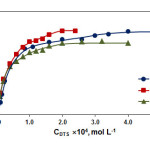Extraction-Chromogenic Systems Containing Iron(III), 4-(2-Thiazolylazo)resorcinol and Ditetrazolium Salts
Kiril B. Gavazov*, Galya K. Toncheva, Teodora S. Stefanova and Kiril K. Simitchiev
University of Plovdiv “PaissiHilendarski”, 24 TzarAssen Str., BG-4000 Plovdiv, Bulgaria
Corresponding author Email: kgavazov@uni-plovdiv.net
DOI : http://dx.doi.org/10.13005/ojc/310244
Article Received on :
Article Accepted on :
Article Published : 26 Jun 2015
Liquid-liquid extraction systems containing FeIII, 4-(2-thiazolylazo)resorcinol (TAR), and a ditetrazolium salt (DTS: Neotetrazoliumchlortide, Blue Tetrazolium chloride, or Nitro Blue Tetrazolium chloride), water and chloroform were investigated. The optimum conditions for iron extraction, some equilibrium constants (association constants, distribution constants, and extraction constants), and characteristics (molar absorptivities, Sandell’s sensitivities, limits of detection and quantification) were found. The extracted species are ternary complexes with a general formula of (DT2+)[FeII(TAR)2]. In this formula the metal ion is in oxidation state II, the azo dye is in doubly deprotonated form (TAR2−), and the ditetrazoliumcation (DT) has a charge of 2+.
KEYWORDS:iron(III); azo dye; bis(tetrazolium) salt; liquid-liquid extraction; ternary complex
Download this article as:| Copy the following to cite this article: Gavazov K. B, Toncheva G. K, Stefanova T. S, Simitchiev K. K. Extraction-Chromogenic Systems Containing Iron(III), 4-(2-Thiazolylazo)resorcinol and Ditetrazolium Salts. Orient J Chem 2015;31(2). |
| Copy the following to cite this URL: Gavazov K. B, Toncheva G. K, Stefanova T. S, Simitchiev K. K. Extraction-Chromogenic Systems Containing Iron(III), 4-(2-Thiazolylazo)resorcinol and Ditetrazolium Salts. Available from: http://www.orientjchem.org/?p=9575 |
Introduction
Tetrazolium salts are well-known compounds with multifunctional properties and various applications(1-7). The most important 2,3,5-trisubstituted tetrazolium salts can be divided into two types: monotetrazolium(MTSs) and ditetrazolium (DTSs) (7).Along with applications related to colour changes in biological or non-biological redox systems (6-10), corrosion inhibition (11),and dosimetry of ionization radiation (12), DTS scan be used as extraction reagents (4, 13) by virtue of the ability of their cations (DTz+; z=2 or 1) to form hydrophobic ion-association complexes.Ion-associates of DTz+ with many anions have been described in the literature, e.g. [Cd(SCN)4]2-(14), [Co(SCN)4]2-(15), [CrO3Cl]–(16),[Ga(OH)(PAR)2]2-(17), [MnO4]–(18), [MoO2Cl2(Cat)]2- (Cat=catechol) (19), [MoO2(4NC)2]2- (4NC=4-nitrocatechol) (20), PAR– (PAR=4-(2-pyridylazo)resorcinol) (21), [ReCl6]2-(22), [ReO4]–(23), TAR– (TAR=4-(2-thiazolylazo)resorcinol) (21), [VO(PAR)2]2-(24), [VO2(PAR)2]3-(25),[VO(OH)2(TAR)]2-(25), [VO2(TAR)2]3-(26), [Zn(SCN)4]2-(14), etc. However, to the best of our knowledge, ditetrazolium complexes with participation of iron have not been a subject of investigation until now.
In this work we describe studies on liquid-liquid extraction systems containing FeIII, TAR, DTS, water, and chloroform. The most important commercially available DTSs were used, namely: (i) (3,3′-(4,4′-biphenylene)bis(2,5–diphenyl-2H-tetrazolium chloride; Neotetrazoliumchlortide, NTC); (ii) (3,3′-(3,3′-dimetoxy-4,4′-biphenylene)-bis(2,5-diphenyl-2H-tetrazolium) chloride; Blue Tetrazolium chloride, BTC); and (iii) (3,3′-(3,3′-dimetoxy-4,4′-biphenylene)-bis[2,5-di(4-nitrophenyl)-2H-tetrazolium] chloride; Nitro Blue Tetrazolium chloride, NBT).
Ion-association complexes of cations, deriving from MTSs and iron-containing chelate anionshave been recently investigated in our laboratory (27-29). The results for the extraction-chromogenic system FeIII-TAR-MTS-water-chloroform (27) suggested that the initial oxidation state of Fe (i. e. III) lowers to II during the process of formation and extraction of the ternary complex. Some characteristics and applications of binary Fe-TAR complexes (30-35) and information concerning the FeIII reduction under certain conditions(35-37) can be found in the literature.
Materials and Methods
A stock iron(III) solution (1 mg mL−1; 1 L) was prepared by dissolving 8.6350 g of FeNH4(SO4)2.12H2O (99.1%; Reanal, Hungry)in water containing 5 mL of conc. H2SO4. Working solutions (50 µg mL−1) were prepared every day by suitable dilution of the stock solution with 0.01 mol L−1 H2SO4(27, 28). TAR (97%), NTC (“for microbiology” grade), BTC (“for microbiology” grade), and NBT (98%) were purchased from Sigma–Aldrich Chemie GmbH. Aqueous solutions of the mentioned reagents were prepared: CTAR=3´10–3mol L−1, and CDTS=2´10–3mol L−1.The chloroform was additionally distilled before use. The acidity of the aqueous medium was set by the addition of buffer solution, prepared by mixing 2 mol L−1 aqueous solutions of CH3COOH and NH4OH. The pH was checked by a Hanna HI 83140 pH meter. A Camspec M507 spectrophotometer (United Kingdom), equipped with 0.5cm path-length cells, was used for reading the absorbance of the extracts.A Microwave Plasma – Atomic Emission Spectrometer Agilent 4200 MP-AES was employed for determining the iron content in residual aqueous phase obtained after extraction.
Procedure for establishing the optimum conditions
Aliquots of Fe(III) solution, TAR solution (up to 2.0 mL), DTS solution (up to 2.5 mL) and buffer solution (3 mL; pH ranging from 4.4 to 8.5) were introduced into 125-mL separatory funnels. The resulting mixtures were diluted with distilled water to a total volume of 10 mL. 10 mL of chloroform were added and the funnels were shaken for a fixed time (up to 5.0 min). A portion of each organic extract was transferred through a filter paper into a cell and the absorbance was read against a blank by the UV-VIS spectrophotometer.
Procedure for determining the fractions extracted and constants of distribution
The fractions extracted (E%) and constants of distribution (KD) were calculated by comparison of the iron content (determined by MP-AES at wavelengths 371.993, 373.486,and 302.064 nm) in the aqueous phase before and after the extraction. The initial concentration of FeIII in the aqueous phase was 2.24´10-5mol L-1 and the extraction was performed under the optimum conditions (Table 1; pH=6.3).
Results And Discussion
Absorption spectra and effect of pH
Absorption spectra of the chloroform extracted ternary complexes are shown in Fig. 1. All three Fe-TAR-DTS complexes have maxima at ca. 618-620 nm (curves 1-3). Additional maxima can be observed in the spectra when the extraction is performed at relatively low pH: e.g. pH 4.1 for the systems with NTC and BTC (curves 1’, 2’), or pH 5.7 for the system with NBT (curve 3’).These maximaare the most pronounced for the NBT complex. This fact can be explained with the lowest stability and molar absorptivity of (NBT2+)(TAR–)2(21) – the salt-like compound which determines the absorption of the blank: Log βNBT-TAR= 8.3, emax=1.95´104 L mol-1 cm-1. The corresponding values for (NTC+)2(TAR–)2 and (BT2+)(TAR–)2are higher (21). Hence, the resultant absorption Al = AFe-TAR-DTS– ATAR-DTS is strongly affected by the ATAR-DTS, especially when TAR is predominantly in anionic form (pH>pKTAR;pKTAR=6.23 (38)) and l< 550 nm. As a result, the peaks of the ternary Fe-TAR-DTS complexes in this spectral region disappear (curves 1-3).
At pH>pKTAR, the maxima of the ternary Fe-TAR-DTS complexes appears at 618 or 620 nm (Table 1). The absorbance of the blank is negligible in this spectral region (Figure 2, curves 1’-3’) and the obtained spectrophotometric results are stable in time and repeatable. Hence, these maxima were used for our further spectrophotometric measurements.
The effect of pH on the absorbance is shown in Fig. 2. It can be assumed that the shape of the pH-curves is governed by two factors: (i) doubly protonated TAR speciespredominate at low pH values; and (ii) Iron hydrolysis(39) exert noticeable effects on the complex formation at pH higher than pHopt.
Table1: Optimum extraction-spectrophotometric conditions (a)
| System | Organic solvent | λ, nm |
pH |
CTAR, mol L–1 |
CDTS, mol L–1 |
Extraction time, min |
| FeIII-TAR-NTC | Chloroform | 618 |
5.5-7.7 |
2.0×10–4 |
4.0×10–4 |
2 |
| FeIII-TAR-BTC | Chloroform | 618 |
5.5-7.1 |
4.0×10–4 |
2.0×10–4 |
2 |
| FeIII-TAR-NBT | Chloroform | 620 |
5.6-7.5 |
5.0×10–4 |
2.0×10–4 |
2 |
a – optimization experiments performed at room temperature (ca. 22°C) and CFe=2.24×10-5mol L-1
 |
Figure1: Absorption spectra of extracted ternary complexes. CFe(III)=2.24×10–5mol L-1; CTAR=2.0×10–4mol L–1, CNTC=4.0×10–4, (curves 1,1’); CTAR=4.0×10–4mol L–1, CBTC=2.0×10-4(curves 2, 2’); CTAR=5.0×10-4mol L–1, CNBT=2.0×10-4mol L–1 (curves 3,3’); pH=7 (curves 1,3), pH=6.3 (curve 2), pH=4.1 (curves 1’,3’), pH=5.7 (curve 2’) Click here to View figure |
 |
Figure2: Effect of pH on the absorbance of extracted ternary complexes. CFe(III)=2.24×10–5mol L–1 (curves 1-3); CTAR=2.0×10–4mol L–1, CNTC=2.6×10–4mol L–1, l=618 nm (curves 1,1’); CTAR=2.0×10–4mol L–1, CBTC=4.0×10–4mol L–1, l=618 nm (curves 2,2’); CTAR=2.0×10–4mol L–1, CNBT=4.0×10–4 mol L–1, l=620 nm (curves 3,3’) Click here to View figure |
Effect of reagents concentration
The effect of TAR and DTS concentrations on the absorbance is shown in Fig. 3 and Fig. 4, respectively. The optimum reagents concentrations deduced from these figures are shown in Table 1.
 |
Figure3: Effect of the TAR concentration on the absorbance of extracted complexes. CFe(III)= 2.24×10–5mol L–1 (curves 1-3); CNTC = 2.6×10–4mol L–1, pH=7.0, l=618 nm (curve 1); CBTC = 2.0×10–4mol L–1, pH=6.3, l=618 nm (curve 2);CNBT = 2.0×10–4mol L–1, pH=5.7, l=620 nm (curve 3) Click here to View figure |
 |
Figure4: Effect of the DTS concentration on the absorbance of extracted complexes. CFe(III) = 2.24×10–5mol L–1 (curves 1-3); CTAR = 2.0×10–4mol L–1, pH=7.0, l=618 nm (curve 1); CTAR = 4.0×10–4mol L–1, pH=6.3, l=618 nm (curve 2); CTAR = 2.0×10–4mol L–1, pH=5.7, l=620 nm (curve 3) Click here to View figure |
Effect of shaking time
The extraction equilibria in the Fe-TAR-DTS systems are reached for ca.90 seconds. We shook the funnels for 2 min in our further experiments.
Composition, molecular formulae and equilibrium constants
The molar TAR-to-Fe and DTS-to-Fe ratios were determined from the experimental results presented in Fig. 3 and Fig. 4, respectively. Two different methods were used: the mobile equilibrium method(40)(Table 3) and the straight-line method of Asmus(41). The results show that the molar ratio between the components of the ternary complex – Fe, TAR and DTS – is 1:2:1. This molar ratio, along with the spectral characteristics (which are similar to these for the Fe-TAR-MTS complexes (27)), give us grounds to assume that the iron ion has an oxidation state of II,TAR is in doubly deprotonated form (TAR2-), and DTz+ has a charge of 2 (DT2+).
If we assume that the FeIII reduction takes place in the aqueous phase, we can write the following equations of ion-association (1) and distribution (2):

The constants of association (b) describing eq. 1 were determined by several methods: the Holme-Langmyhr method(42),the Harvey-Manning method(43), and the mobile equilibrium method(40). The constants of distribution (KD) describing eq. 2 were calculated by the formula KD=E/(1-E), where E is determined by MP-AES at the optimum extraction conditions (as described above). The attempts to determine these constants spectrophotometrically by comparison of the absorbance values obtained after single (A1) and triple (A3) extractions in equal final volumes(26-28) were unsuccessful, since A1 was higher than A3. This anomaly was greater than that observed in (27) for the FeIII-TAR-TTC system (TTC=2,3,5-triphenyl-2H-tetrazolium chloride). It can beattributed tothe formation of substances with different colour properties during the oxidation-reduction process involving ironor during the dilution of the organic extracts with chloroform.
The extraction constants (Kex) were calculated by the formula Kex=KD´b(44). All experiments were performed atroom temperature of ca. 22°C.The results are given in Table 2.
Table2: Calculated values of the fractions extracted (E%), distribution constants (KD), association constants (β), and extraction constants (Kex)
| Extraction system |
E% (f) |
Log KD |
Log b(f) |
Log Kex |
| FeIII-TAR-NTC |
89±1 (N=3) |
0.9 (a) |
4.7±0.2 (N=11) (b); 4.6±0.2 (N=3)(c); 4.7±0.2 (N=7) (d) |
5.6 (e) |
| FeIII-TAR-BTC |
85±1 (N=3) |
0.8 (a) |
4.9±0.1 (N=9) (b), 4.9±0.2 (N=3) (c); 4.9±0.2 (N=8) (d) |
5.7 (e) |
| FeIII-TAR-NBT |
94±1 (N=3) |
1.2(a) |
4.9±0.1 (N=9) (b); 5.0±0.2 (N=3) (c); 4.9±0.2 (N=8) (d) |
6.1 (e) |
a – calculated by the equation KD=E/(1-E); b– Holme-Langmyhr method; c– Harvey-Manning method; d– Mobile equilibrium method; e – by the equation Log Kex = Log KD+ Log β; f – ±SD
Table3: Slopes (a) (a), intercepts (b) (a), and R2-values of straight line equations obtained by the mobile equilibrium method
| Extraction system |
TAR:Fe=2:1 |
DTS:Fe=1:1 |
| FeIII-TAR-NTC |
a=2.1±0.2; b=9.1±0.8; R2=0.9710 (N=6) |
a=1.05±0.05; b=5.0±0.2; R2=0.9883 (N=7) |
| FeIII-TAR-BTC |
a=2.1±0.1; b=8.7±0.6; R2=0.9647 (N=10) |
a=1.00±0.05; b=4.9±0.2; R2=0.9857 (N=8) |
| FeIII-TAR-NBT |
a=2.04±0.08; b=8.3±0.3; R2=0.9855 (N=11) |
a=0.97±0.03; b=4.8±0.1; R2=0.9937 (N=8) |
a – ±SD
Table4: Characteristics concerning the application of the ion-association complexes for extractive-spectrophotometric determination of iron
| Analytical characteristics |
FeIII-TAR-NTC |
FeIII-TAR-BTC |
FeIII-TAR-NBT |
| Linear range, µg mL–1 |
up to 1.5 |
up to 3.2 |
up to 2.5 |
| Molar absorptivity (e), L mol–1 cm–1 |
4.3×104 |
4.5×104 |
3.9×104 |
| Sandell’s sensitivity (SS), ng cm–2 |
1.3 |
1.2 |
1.4 |
| Limit of detection (LOD), µg mL–1 |
0.07 |
0.07 |
0.09 |
| Limit of quantification (LOQ), µg mL–1 |
0.23 |
0.22 |
0.30 |
Beer’s law and analytical characteristics
The adherence to Beer’s law for each FeIII–TAR–DTS–water–chloroform system was examined under the optimum extraction-spectrophotometric conditions. Then the molar absorptivities, Sandell’s sensitivities, limits of detection (LOD) and limits of quantification (LOQ) were calculated. The results are given in Table 4.
Conclusion
Cations deriving from DTSs were studied for the first time as components of ion-association systems containingiron. These cations form chloroform-extractable ion-pairs with the anionic Fe-TAR chelate, which can be represented with the formula [FeII(TAR2-)2]2-, independently of the fact that the initial oxidation state of iron was III. The calculated equilibrium constants and characteristics suggest that the DTS-TAR couples canbe applied for iron extraction. However, the greatest potential in this field has NBT which form the most stable and extractable complex.
Acknowledgments
The authors express their gratitude to the Research Fund of the University of Plovdiv “PaisiiHilendarski” (Project NI15-HF001).
References
- Zhivich, A. B.; Koldobskii, G. I.; Ostrovskii, V.A. Chem. Hetero. Comp. 1990, 26, 1319-1328
- Daniel, D.S., The chemistry of tetrazolium salts, in Chemistry and applications of leuco dyes, (Muthyala R., Ed.), Springer US, (2002) 207-296
- Berridge, M. V.; Herst, P. M.; Tan A. S. Biotechnol. Annu. Rev.2005, 11 (Suppl.), 127-152
- Gavazov, K. B.; Dimitrov, A. N.; Lekova V. D. Russ. Chem. Rev. 2007, 76, 169-179
- Şenöz, H. Hacettepe J. Biol. & Chem.2012, 40, 293-301
- Sabnis R. W., Handbook of biological dyes and stains: synthesis and industrial applications; Wiley, Hoboken,New Jersey, (2010)
- Pádr, Z., Tetrazolium salts, their preparation and use in biology and medicine; Statnizdravotnickenakladatelstvi. Praha (1959) (in Czeck)
- Pitschmann, V.; Kobliha, Z.; Tušarová,I. Adv. Mil. Technol.2011, 6, 19-27
- Shugalei, I. V.; Ivanova, A. A.; Ilyushin, M. A.; Tselinskii, I. V.; Sokolova, V. V. Russ. J. Gen. Chem.2010, 80, 829-835
- Iuchi, K.-i.; Ohko, Y.; Tatsuma, T.; Fujishima, A. Chem. Mater.2004, 16, 1165-1167
- Li, X. H.; Deng, S. D.; Fu, H. Corr. Sci.2010, 52, 2786-2792
- Pikaev, A.K.; Kriminskaya, Z.K. Russ. Chem. Rev. 1998, 67, 671-680
- Alexandrov, A., Tertazolium salts for solvent extraction of elements as ion association complexes. Review.Universität des Saarlandes.Saarbrücken (1984)
- Kamburova, M. Zh. Anal. Khim.1993, 48, 1161-1166
- Kamburova, M.; Aleksandrov, A. Zh. Anal. Khim.1999, 54, 277-280
- Kostova, D. J. Anal. Chem. 2014, 69, 1030-1036
- Stojnova, K. T.; Gavazov, K. B.; Lekova V. D. ActaChim. Slov.2013, 60, 390-396
- Kamburova, M., Determination of microelements in plants and soils with tetrazolium salts, D.Sc. thesis, BAS. Sofia, (1999) (in Bulgarian)
- Singh, A.K.; Kumar D. Analyst1985, 110, 751-753
- Gavazov, K.; Lekova, V.; Boyanov, B.; Dimitrov, A., J. Therm. Anal. Cal. 2009, 96, 249-254
- Gavazov, K.B.; Toncheva, G.K. Russ. J. Gen. Chem.2015, 85, 192-197
- Simeonova, Z.; Alexandrov, A.; Dicheva, S. Talanta1995, 42, 867-869
- Alexandrov, A.; Simeonova Z., Thermochim. Acta1986, 107, 123-129
- Genç, F.; Gavazov, K.B.; Türkyilmaz, M. Cent. Eur. J. Chem. 2010, 8, 461-467
- Gavazov, K. B.;Racheva, P. V.;Lekova, V. D.;Dimitrov, A. N.;Turkyilmaz, M.;Genc, F.Croat. Chem. Acta2012, 85, 53-58
- Gavazov, K. B.; Lekova, V. D.; Dimitrov, A. N.; Patronov, G. I. Cent. Eur. J. Chem. 2007, 5, 257-270
- Gavazov, K. B.; Stefanova, T. S.; Toncheva, G. K. J. Advanc. Chem.2014, 10, 2491-2501
- Toncheva, G. K.; Stefanova, T. S.; Gavazov K. B. Oriental J. Chem. 2015, 31, 327-332.
- Gavazov, K. B.; Delchev, V. B.; Toncheva, G. K.; Georgieva, Z. G. Russ. J. Gen. Chem.2015, 85, accepted
- Russeva, E.; Kuban, V.; Sommer, L. Coll. Czech. Chem. Commun. 1979, 44, 374-392
- Karipcin, F.; Kabalcilar, E.; Ilican, S.; Caglar, Y.; Caglar, M., Spectrochim. ActaA2009, 73, 174-180
- Beyramabadi, S. A., Bulg. Chem. Commun. 2014, 46, 31-35
- Lin, C.-s.; Zhang, X.-s.; Liu, X.-z. Analyst1991, 116, 277-279
- Soylak, M.; Yilmaz, E. J. Hazard. Mater.2010, 182, 704-709
- Dolezal, J.; Sommer, L. Coll. Czech. Chem. Commun. 1994, 59, 2209-2226
- Susanto, D., Optimization of iron analyses using ESI-MS: detection of iron oxide in pharmaceuticals, Concordia University. Montreal, (2009)
- Yotsuyanagi, T.; Yamashita, R.; Aomura, K. Anal. Chem. 1972, 44, 1091-1093
- Marić, L.; Široki, M. Anal. Chim.Acta1996, 318, 345-355
- Stefánsson, A. Environ. Sci. Technol. 2007, 41, 6117-6123
- Zhiming, Z.; Dongsten, M.; Cunxiao, Y. J. Rare Earths1997, 15, 216-219
- Asmus, E. Fresenius’ J. Anal. Chem. 1960, 178, 104-116
- Holme, A.; Langmyhr, F. J. Anal. Chim.Acta, 1966, 36, 383-391
- Harvey, A. E.; Manning, D. L. J. Am. Chem. Soc. 1950, 72, 4488-4493
- Alexandrov, A.; Budevski, O; Dimitrov, A. J. Radioanal. Chem.1976, 29, 243-250

This work is licensed under a Creative Commons Attribution 4.0 International License.









